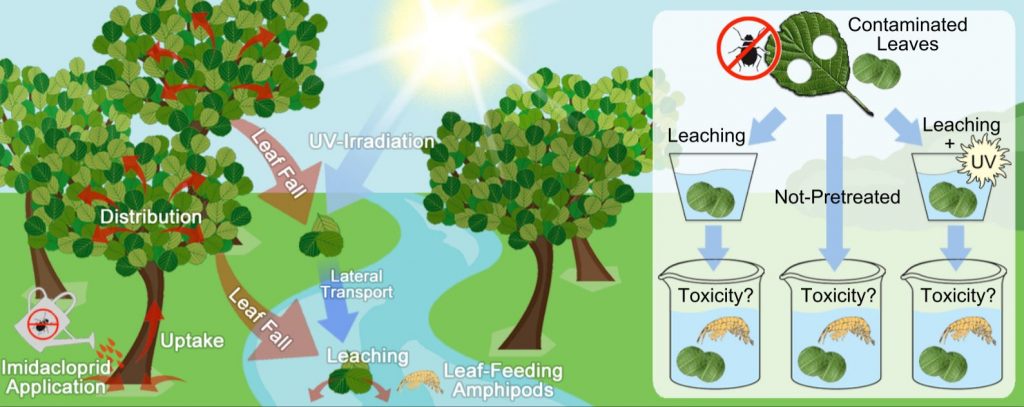In this post, we talk about our recently published paper “UV-irradiation and leaching in water reduce the toxicity of imidacloprid-contaminated leaves for the aquatic leaf-shredding amphipod Gammarus fossarum“.
Imidacloprid, a systemic neonicotinoid insecticide, is increasingly applied against insect pest infestations on forest trees. However, leaves falling from imidacloprid-treated trees may reach nearby surface waters. There, leaf-shredding invertebrates could be particularly exposed to imidacloprid residues accumulated in these leaves since they heavily rely on allochthonous organic material as food source. Given imidacloprids’ susceptibility towards photolysis as well as its affinity for the water phase, we hypothesized that the leaves’ toxicity might be modulated by sunlight (i.e., UV-irradiation) during decay on the forest floor, or by remobilization of the insecticide from leaves within the aquatic environment.
To test this hypothesis, the leaf-shredding amphipod Gammarus fossarum was fed for 7 days with imidacloprid-contaminated leaves (Alnus glutinosa) that had either been submerged in water for 1, 3 and 7 days or UV-irradiated for 1 day at field relevant intensities (followed by leaching over 1 day) while the test organisms’ leaf consumption was monitored.
When feeding on imidacloprid-contaminated leaves without any pretreatment an up to 80% reduction in gammarids’ leaf consumption was observed compared to the imidacloprid-free control. In contrast, both leaching of imidacloprid from leaves (for 7 days) as well as UV-irradiation reduced the leaves’ imidacloprid load (by 46 and 90%) thereby mitigating the effects on the organisms’ leaf consumption to levels comparable to the respective imidacloprid-free controls.
Although dietary exposure of G. fossarum decreased with increasing leaching duration, imidacloprid concentrations remobilized from leaves are expected to expose downstream communities via the water phase. Therefore, natural factors, such as photodegradation and remobilization of foliar insecticide residues in water, should be considered when evaluating the risks neonicotinoid-contaminated plant material pose for aquatic organisms.
The paper was authored by Dominic Englert, Jochen P. Zubrod, Christoph Neubauer, Ralf Schulz and Mirco Bundschuh and published in Environmental Pollution.

